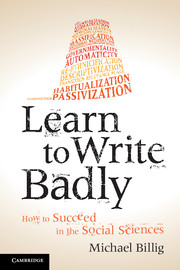Book contents
- Frontmatter
- Contents
- Acknowledgements
- 1 Introduction
- 2 Mass publication and academic life
- 3 Learning to write badly
- 4 Jargon, nouns and acronyms
- 5 Turning people into things
- 6 How to avoid saying who did it
- 7 Some sociological things: governmentality, cosmopolitanization and conversation analysis
- 8 Experimental social psychology: concealing and exaggerating
- 9 Conclusion and recommendations
- References
- Index
5 - Turning people into things
Published online by Cambridge University Press: 05 June 2013
- Frontmatter
- Contents
- Acknowledgements
- 1 Introduction
- 2 Mass publication and academic life
- 3 Learning to write badly
- 4 Jargon, nouns and acronyms
- 5 Turning people into things
- 6 How to avoid saying who did it
- 7 Some sociological things: governmentality, cosmopolitanization and conversation analysis
- 8 Experimental social psychology: concealing and exaggerating
- 9 Conclusion and recommendations
- References
- Index
Summary
Social scientists in their writings often give pride of place to the sorts of theoretical things that they create, especially if these theoretical things are big words ending with ‘ization’ or ‘ification’. In the race for status, using smaller words to describe what people do comes a long way down the field. Grammatically this difference in status is reflected in the way that nouns seem to take precedence over verbs. Stylistically this is reflected in a tendency to produce unpopulated, rather than populated, writing. This does not mean that all pieces of writing are either completely unpopulated or completely populated, either filled with theoretical things or filled with depictions of people. Much social scientific writing will be mixed, containing populated and unpopulated passages and sentences. The higher status of unpopulated writing can be seen within texts where writers will use descriptions of people in order to serve the theoretical things that they value. As I will suggest in this chapter, the movement tends to be one way, as writers seem to move from people to things – from verbs to technical nouns.
There are also writings where people hardly get a look in at all. Sometimes, social scientific writing seems to resemble jigsaw puzzles. The writers have slotted their theoretical things together, fitting one concept into another with little reference to actual people and their lives. I will be giving some examples of this jigsaw writing. By and large, one might say that such writers reify the social world, by turning the actual world of people into a world of theoretical things, albeit neatly arranged theoretical things. In the social sciences there is a long-established tradition of writers warning about the dangers of turning people into things, often using the concept of ‘reification’ to flag up their warning.
Information
- Type
- Chapter
- Information
- Learn to Write BadlyHow to Succeed in the Social Sciences, pp. 95 - 114Publisher: Cambridge University PressPrint publication year: 2013
Accessibility standard: Unknown
Why this information is here
This section outlines the accessibility features of this content - including support for screen readers, full keyboard navigation and high-contrast display options. This may not be relevant for you.Accessibility Information
- 1
- Cited by
